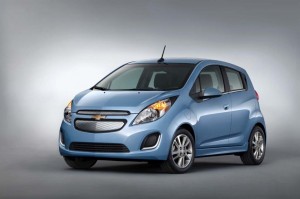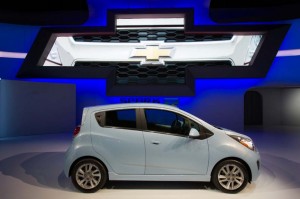Is there a market for small battery-electric vehicles in the U.S. market? Buyers be damned, it’s full speed ahead for the auto industry – in large part due to strict new rules passed by California’s seemingly all-powerful regulators. Over the next several years you’ll see so-called Zero-Emission Vehicles coming from all the major auto manufacturers – unless they’re comfortable with being locked out of the huge California market.
Among the new offerings is the 2014 Chevrolet Spark EV. The electrified version of Chevy’s new minicar is the first General Motors battery-electric vehicle, or BEV, since the old GM EV1 was abandoned back in 1999.
Officially unveiled at the recent LA Auto Show, TheDetroitBureau.com was invited to attend a background briefing on the Spark EV – including a short drive. While we didn’t have enough time behind the wheel to deliver the sort of full review we’d prefer we did get a sense of what to expect from the little battery car.
For those who might lump minicars and battery vehicles into the same, boring green category, the 2014 Chevrolet Spark EV is no stone pony. Quite the contrary. In fact, it’s a lot more fun, especially coming off a stoplight, than the gas-powered version of the Chevy minicar.
Step on the throttle and you’ll feel yourself pushed back into your seat. No, this isn’t an electric Camaro, but it helps to recall that electric motors generate maximum torque the moment they start spinning. A number of other battery cars, such as the Nissan Leaf, will also give you a quick thrill at launch. But unlike some competing BEVs, the Spark EV doesn’t back down by the time you’re running 35 to 40 mph. Our test car kept pulling all the way up to and beyond 60 – as fast as we risked going on our little test route near San Francisco.
Chevrolet claims the battery car will launch from 0 to 60 in less than 8 seconds, where the 1.2-liter gas model can barely manage the same task in just under 11 seconds.
Of course, it helps that the Spark EV’s motor turns out 130 horsepower and a shocking 400 pound-feet of torque compared with just 84 hp and 83 lb-ft for the internal combustion model.
Chevy engineers are still working up some final details, so we’ve yet to get confirmation on some other key details, such as battery size and range – but we got hints suggesting the pack will be just a bit larger than the batteries in the Chevrolet Volt plug-in, likely between 20 and 22 kilowatt-hours. The Spark EV will use a different chemistry designed to maximize “energy density,” the amount of power stored in a given mass, so pound-for-pound, it will have a little more juice, so to speak.
Meanwhile, the Chevrolet Spark EV will be able to use more of the total energy its batteries can hold, allowing for greater range. With the Volt, Chevy erred on the cautious side, only drawing down about 60 to 65% of the energy in its pack. We’re betting it will come closer to 80% with the Spark EV.
(Competitors, such as Tesla with the Model S, go even further, to 90% and even 95% of the energy stored in the pack, though some experts fret this strategy reduces battery life.)
As for range, look for something just under 100 miles. The goal is to have the highest range of any BEV on the market – other than the Tesla Model S, Chevy officials promised.
Chevy will equip the new battery-car with the capability to use Level III, or 480-volt DC, charging stations. That will allow it to get an 80% “refill” in as little as 20 minutes. On a conventional 240-volt Level II charger, expect to take about 4 hours. As for plugging into a 120-volt wall socket, well, you better not need to go anywhere fast, as it will likely take a full day.
During our brief drive we didn’t have the chance to really test the driving manners of the new Chevrolet Spark EV. Our first run exhibited fairly good on-road characteristics, steering feeling pretty close to that of the Spark with the 1.2-liter engine. In other words, a typical minicar with a moderate amount of road feel. We’re looking forward to getting a bit more time to flog the Spark EV around as the low-mounted battery pack actually translates into an improved center of gravity that could make it easier to toss around.
Careful battery placement also meant that you lose very little of the space available in the already cramped gas-powered Spark.
Unlike the Volt, Nissan Leaf and the Ford C-Max Energi plug-in, Chevy has decided to make minimal changes to the exterior and interior of the Spark to declare its green bona fides. Other motorists would have to spot its modest badging.
Inside, it’s largely a conventional Spark – but for a revised gauge cluster that offers a number of features telling you the battery’s state of charge, the amount of energy you’re consuming – and offering tips on how to improve your range.
The 2014 Chevrolet Spark EV also will be paired to new smartphone apps that will allow you to remotely query the vehicle to check battery condition and even schedule when to start charging. You’ll also be able to “pre-condition” the vehicle, starting up the climate control system so it’s comfortable in the cabin even before you slip inside. If you do that while still connected to a charger you won’t diminish your range.
The battery car will share all the other new apps and features available for the Chevrolet Spark gas model through the ChevyMyLink infotainment system. Chevy is planning to add a special button in Spark, for example, that will directly call up Apple’s Siri personal assistant.
The maker apparently has some ambitious sales goal for the Spark. But how well it does will likely depend, at least in part, on pricing. We’re expecting the 2014 Chevrolet Spark EV to come in as one of the more affordable battery-electric vehicles, probably in the low-$20,000 range after you account for the $7,500 federal tax credit on advanced technology vehicles.
That would, however, still be a stiff premium over the gas model’s base $12,245. Nonetheless, we expect to see a moderate market for the new model. It’s quick and it’s fun and it seems a competitive value for those that really want battery power.
We’ll have more to say after we get a more lengthy test drive.


